I hated client contracts before I sold the first one.
Convinced I needed contracts to be a “legitimate gym business,” I copied something I found online and presented it to Client 001 and 002, a father and son.
“What if we don’t like it?” the father asked. I probably gave him some backpedalling speech about commitment to his goals.
“What if he gets hurt playing football?” he glanced at his son, a teenager.
“There’s stuff we can do. I’ll give him some rehab work,” I said, already over-promising.
Guess what happened?
A year later, after enforcing the contract with some clients and not others; after losing sleep over every cancellation request; after turning away potential clients who loved the workouts but weren’t ready to make a commitment, contracts were my biggest source of stress. But I was also barely breaking even. I thought I just needed to “harden up” and enforce the contracts better.
Or, as my mentor suggested, I could find another way to keep people around.
First, I had to define what I was trying to improve. The science of keeping people around can really be measured two different ways:
- Retention – The span of time between a client’s first visit and their last;
- Adherence – the frequency of a client’s visits (usually per week or month.)
While these numbers are loosely correlated, there’s no direct parallel (for example, a client who attends more times per week NOW isn’t more likely to stay longer, necessarily.)
To me, the retention numbers that matter are year-over-year retention. Others measure retention as the likelihood of a second purchase:
“We have 75% retention after OnRamp!” – that means 3/4 of the people who finish your on-ramp program sign up for at least one month of your service. What if they all quit after the first month? Year-over-year is what matters to me.
When I started developing our retention system, I thought I could duplicate the best practices of the “big guys.” But when I got my hands on some private data, I was shocked to learn the big chains had a year-over-year retention rate of only 47%. And their adherence rate–a measure of how often a client shows up–was below 30% after the first 90 days. And these folks were all on contracts!
I had a personal relationship with every client. Every cancellation hurt. I knew I couldn’t build a business where one in every two clients quit every year, and two-third of all clients rarely showed up.
The solution became the Bright Spots system, named after Chip and Dan Heath’s concept in “Made to Stick”. It brought our gym to an all-time high retention rate of 93% year-over-year without contracts. I first wrote about Bright Spots in 2010, but my methods were published in the CrossFit Journal in 2009 before I gave them a name.
In 2016, we measure retention using the LEG metric (Length of Engagement). I have clients with a LEG over 13 years. Why is this so important?
Let’s say you have 100 clients paying $100 per month, and a LEG of 10 months. That means every client has a lifetime value of $1,000 ($100 x 10 months). Increasing LEG by one single month for every client means revenues of $10,000!
If I lose 10% of my clients in a year, I have to attract 10 – or one every five weeks – to maintain my size. If I lose 10% in a month, I have to attract 120 new clients – more than two per week – to stay the same size. Imagine replacing every member of your gym every year!
It’s important to know your LEG. It’s more important to have a strategy to improve your LEG. Recruiting new clients is sexy, but keeping a client around for three years is the habit of a real entrepreneur.
You can learn the Bright Spots system from my books, in RampUp and at our seminars.

